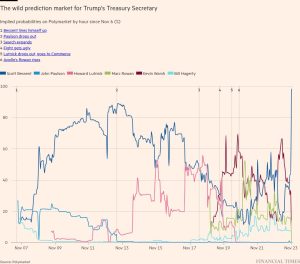US economic growth is strong — so why cut rates?
Stay informed with free updates
Simply sign up to the US economy myFT Digest — delivered directly to your inbox.
The writer is a former chair of the US Federal Deposit Insurance Corporation and a senior adviser to the Systemic Risk Council
Good news for the US economy just keeps pouring in. Wages are up. The stock market is up. Job creation is strong. Credit is readily available. Some have called it a “Goldilocks economy,” but it feels more like Papa Bear’s soup, running a bit hot.
Yet the Federal Reserve Board seems determined to keep turning up the heat with more rate cuts. Chair Jay Powell has signalled that these will be gradual. But with economic growth this strong, why cut at all?
If there is a warning sign for our economy, it can be found in persistently high and rising core inflation. The most recent Consumer Price Index report had core inflation, which excludes volatile food and energy prices, at 3.3 per cent. While “headline inflation” is lower, holding steady at 2.4 per cent, this is partly due to past declines in energy costs which are now rising as war spreads in the Middle East. The most recent University of Michigan survey shows consumer inflation expectations rising sharply.
The main rationale for more cuts is to stimulate a supposedly cooling labour market. But with an unemployment rate of 4.1 per cent and 254,000 jobs created in September, it is only cooling from the red-hot numbers we saw in 2022 and early 2023 when the economy came roaring back from the pandemic. Even if the economy needed stimulus (which it doesn’t), there is no guarantee that businesses would use lower borrowing costs for job-producing investments. They could just as well borrow to invest in AI or make acquisitions which would reduce jobs.
Another reason is to stimulate consumption by lowering consumer borrowing costs. Yet consumer spending is already robust. Household debt is at a record high of $17.8tn. Rate cuts will encourage even more borrowing and less saving.
The biggest threat to consumers is not lack of credit. It is a resurgence of inflation, which hits low- and middle-income households the hardest. Rising costs of goods and services are behind those large credit card balances.
Similarly, high home prices — up more than 50 per cent over the past five years — are more of an obstacle to housing affordability than mortgage rates, which are low by historic standards. Stimulating demand through rate cuts risks even higher inflation which would more than offset any consumer savings from a marginal decrease in borrowing rates.
Rate cuts would also decrease the returns that households receive on their savings. Working families need a safe, stable place to keep their emergency funds and other short-term savings. So do older adults for their retirement money. They are finally getting a decent, real return. We shouldn’t take that away from them.
Who do rate cuts help? Profligate borrowers such as struggling commercial real estate borrowers, overleveraged private equity funds and debt-laden zombie companies would benefit. So would banks with hundreds of billions of unrealised losses on their securities portfolios. Purveyors of risk assets like cuts. As rates decline on safe assets like bank deposits and money market funds, more investment dollars move into riskier stocks and alternative investments in pursuit of higher returns.
Rate cut advocates complain that rising rates have made lending more profitable for banks. A recent FT headline notes that the Fed’s rate increases handed banks a “$1tn windfall”. But the windfall partially reflects a normalisation of interest margins, which plunged to aberrational lows during the pandemic when the Fed took real rates negative.
It is right to call out the largest US banks for being slow to raise deposit rates for customers, unlike their smaller competitors where 5 per cent-plus rates have long been available. But the culprit in this is the market dominance and privileged too-big-to-fail status of big banks, not the rate rises which have benefited savers.
The hue and cry for rate cuts in the face of such strong economic data show how conditioned society has become to the idea that such cuts are always good for the economy. But as I have previously written, there is scant empirical research to support that assumption and plenty that shows low rates come with nasty side effects like corporate consolidation, wealth inequality, low productivity and a build-up of leverage.
Higher rates have brought us a delicious stew of GDP growth exceeding 3 per cent, while households enjoy rising real wages and returns on their savings. The Fed should not stir the pot with further cuts.
#economic #growth #strong #cut #rates





